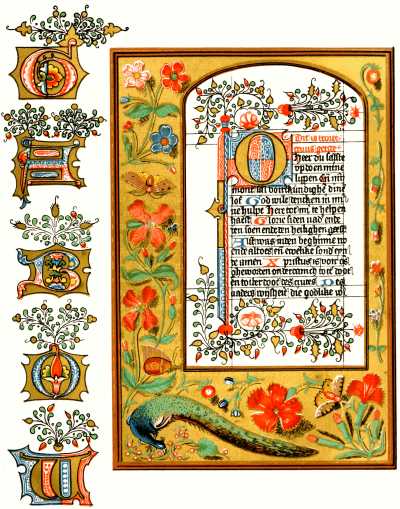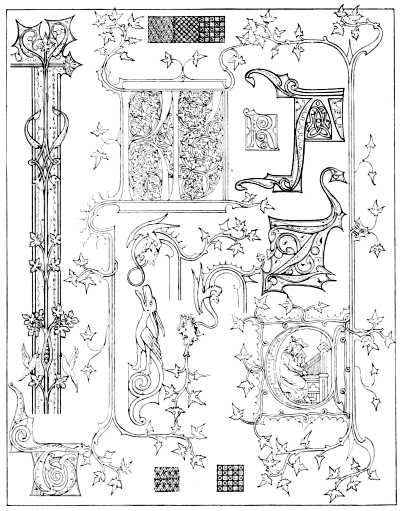

Left: Plate VI. Page and Initials (Low Countries, 15th Century). Border from MS. in British Museum. Right: French Initial Letters and Border Ornaments — Fourteenth Century from Lessons in the Art of Illuminating by W. J. Loftie. Source: Project Gutenberg EBook #40423 produced by Chris Curnow, Matthew Wheaton and the Online Distributed Proofreading Team. [Click on images to enlarge them.]
Description of Plate VI

page of writing and five separate initials from a book of "Hours," written in Flanders or Holland at the end of the fifteenth century, are here shown, with a border of the same period from another volume. The first book, which is in a private collection, affords an example of the kind of illumination which is styled by the French "grisaille," a word which may be translated "grey-work." In this style, which consists usually in the artist restricting himself to certain colors, or to black, grey, and white only, very few books were ever written. I have already, in the General Sketch, mentioned one which had pictures in imitation of Limoges enamels. A volume apparently illuminated by the same hand as those in our MS. is in the Burgundian Library at Brussels. The figure pictures in both look as if they were not painted by the same artist as the writing and illumination of the letters, and it is probable two or more were employed in the production.
There was great activity in all the arts in the Low Countries during the fifteenth century, and the most gorgeous books ever illuminated were written there at that period. At Dortrecht, at Bruges, and other places there were schools of illuminators, and the practice of the art was not confined, as in England, to ecclesiastics and the cloister. The books written were, however, mainly religious; and the same designs were used over and over again. It would, in fact, be easy to identify each guild of miniature painters by their employment of the same set of forms. This eventually led to deterioration, and only the introduction of oil painting, by turning the minds of the artists into a wider channel, saved Flemish art. The masters of the Van Eycks, of Memling, of Matsys, of Van Romerswale were undoubtedly the teachers of illumination in books.
The artist in "grisaille" always took especial pains with his draperies. He had so little wherewith to produce his effect that he sometimes almost reached the chiaro-scuro of a later period. Some of the pictures of this school which I have seen look as if they were intended to represent moonlight views. In the present volume the effect of the soberly coloured figure subjects is greatly enhanced by the rich colors of the border, and the brilliantly burnished gilding. The ground on which the letter O is gilded in Plate VI., is quartered into red and blue, and the outer part "counter-changed," as they say in heraldry. A delicate pattern is worked over the colors in body-white. The small leaves are painted with thick coats of Emerald Green.
The border is from a Book of Hours in the British Museum. The gilding in the original is laid on with shell, worked very flat and very thin, so as rather to impart a yellow tone to the ground than to give it any special lustre. There are other borders in the book of a similar character, and some which, on a green or a purple ground, show jewels of various kinds, especially pearls, sometimes strewn irregularly over the ground, sometimes worked up into ornaments, or made to look as if they were mounted in richly designed gold settings. In fact, at that age the artist let nothing escape him that would go to enhance the beauty or brilliancy of his page. In the original this border enclosed a very elaborate miniature. These miniatures are very carefully and delicately painted, but perhaps by a different hand, as they are not equal in refinement to the borders. The Office for the Dead is ornamented with a black border, on which is architectural tracery in gold on which skulls are arranged, one of them with a pansy or heartsease and forget-me-not, beautifully painted, growing out of the hollow eyes. The border of the picture of the Annunciation is made with a tall lily growing from an ornamental vase at the side.
The Dutch and Flemish illuminators at this period excelled in manipulation, and many of the books which they painted have all the merit and almost all the importance of pictures. Anything and everything was used as ornament. In some no two pages are even in what can be called the same style; but delicacy of workmanship, the faces especially being finished as real miniatures, is characteristic of all. It is probable that whole schools of artists worked on a single volume, dividing the labour according to the skill of each artist.
On the back of Plate VI. will be found some further examples of the ornaments, letters, and "line finishings" of the thirteenth and fourteenth centuries, chiefly from French books. The A and the Z are from the same MS. as Nos. 6 and 7 on Plate III. The KL united form the heading of the Calendar in a book with ivy pattern borders.
References
Beckwith, Alice H. R. H. Victorian Bibliomania: The Illuminated Book in Nineteenth-Century Britain. Exhibition catalogue. Providence. Rhode Island: Museum of Art, Rhode Island School of Design, 1987.
Loftie, W. J. . Lessons in the Art of Illuminating: A Series of Examples selected from Works in the British Museum, Lambeth Palace Library, and the South Kensington Museum.. London: London: Blackie & Son, nd. “The Colored Illustrations are Printed by W. G. Blackie & Co., Glasgow, from Drawings by J. A. Burt.” Project Gutenberg EBook #40423 produced by Chris Curnow, Matthew Wheaton and the Online Distributed Proofreading Team. Web. 11 January 2014.
Last modified 11 January 2014